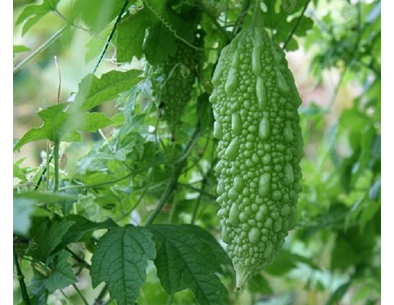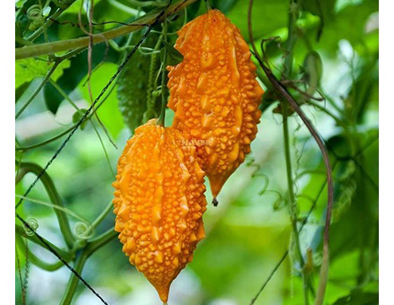Description
Details
Bitter Melon and Diabetes
Bitter melon, also known as bitter gourd or karela (in India), is a unique vegetable-fruit that can be used as food or medicine.
It is the edible part of the plant Momordica Charantia, which is a vine of the Cucurbitaceae family and is considered the most bitter among all fruits and vegetables.
The plant thrives in tropical and subtropical regions, including:
South America
Asia
parts of Africa
the Caribbean
The bitter melon itself grows off the vine as a green, oblong-shaped fruit with a distinct warty exterior - though its size, texture and bitterness vary between the different regions in which it grows - and is rich in vital vitamins and minerals.
How does it affect diabetes?
In addition to being a food ingredient, bitter melon has also long been used as a herbal remedy for a range of ailments, including type 2 diabetes.
The fruit contains at least three active substances with anti-diabetic properties, including charantin, which has been confirmed to have a blood glucose-lowering effect, vicine and an insulin-like compound known as polypeptide-p.
These substances either work individually or together to help reduce blood sugar levels.
It is also known that bitter melon contains a lectin that reduces blood glucose concentrations by acting on peripheral tissues and suppressing appetite - similar to the effects of insulin in the brain.
This lectin is thought to be a major factor behind the hypoglycemic effect that develops after eating bitter melon.
Scientific evidence
A number of clinical studies have been conducted to evaluate the efficacy of bitter melon in the treatment of diabetes.
Bitter Melon on the Diabetes Forum
Karela bitter melon tablets
Bitter Melon/Kerala Fruit
Cinnamon and Bitter Melon for reducing fasting levels
Bitter melon
Bitter melon extract
In January 2011, the results of a four-week clinical trial were published in the Journal of Ethnopharmacology, which showed that a 2,000 mg daily dose of bitter melon significantly reduced blood glucose levels among patients with type 2 diabetes, although the hypoglycemic effect was less than a 1,000 mg/day dose of metformin. [68]
Other older studies have also suggested an association between bitter melon intake and improved glycemic control, while a report published in the March 2008 issue of Chemistry and Biology found that bitter melon increased cellular uptake of glucose and improved glucose tolerance. [69]
However, research published in the Journal of Clinical Epidemiology in 2007 failed to show any benefits of bitter melon for poorly controlled type 2 diabetes, while another clinical review published two years later in the British Journal of Nutrition stated that more, better-designed and clinical trials are required to confirm the fruit’s role in diabetes treatment. [70]
What other health benefits does it have?
Bitter melon is used in traditional medicine for:
Colic
Fever
Burns
Chronic cough
Painful menstruation
Skin conditions
It is also used to heal wounds, assist childbirth and, in parts of Africa and Asia, prevent or treat malaria and viral diseases such as measles and chicken pox.
In addition, researchers from Saint Louis University in the US say they have shown that an extract from bitter melon can kill breast cancer cells and prevent them from growing and spreading.
Additional
Additional
| Country of origin | Korea |
|---|---|
| Health Benefits | blood sugar controller, diabetes, fatigue recovery, gastric ulcer, menstrual pain, skin, vitamin |
| Ingredients | Bitter Melon |
| Directions | Wash the herbs on running water, boil for 1 hour to 2 hours depends on ingredients. |
| Storage Temperature | room temperature |
| Product Package | Loose leaf, Paper sealed bag |
| Good herbal formulation | No |
Reviews
FAQ
Frequently Asked Questions
A: Generally you boil 20g of tea/herb with 2L. of water. The ratio does not matter. However, it is recommended that you control the
saturation of the tea (how strong it is) depending on your personal
preference and body condition.
A: It depends on the tea/herb.
For leaves: boil for 15~20 min.
For hard fruits, roots, and stems: If you soak the tea/herb in water
for 1~2 hours before boiling, you can save time in boiling, and also
get a deeper flavor than without soaking.
A: Currently, what is listed on the site is what we mostly deal with in
retail stores. However, if there is a certain tea/herb that you wish to
get, you can send an email to info@leafnflower.com. or 844-344-0622.
Then, we may offer a price for obtaining the tea/herb, answer questions, and even offer purchase.
A: Yes, you can combine 5~10g of teas/herbs that you already have with Leafnflower.com's teas/herbs.
Although brewing one tea/herb is still good, combining 2~3 teas/herbs helps bring out
the remedial effects of the tea/herbs better than brewing just one tea/herb. However, most tea/herbs contain natural toxins,
and it is recommended that you boil 1~2 pieces of liquorice root along with the tea/herb to remove the toxin.

